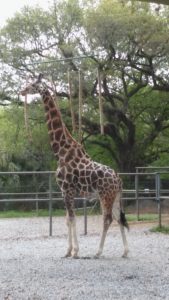Based on what I’ve been reading over the last two weeks, I am not the only person to ask this question, nor is it a recent development. At least as early as 1926, published literature was asking whether African big game populations were declining (Friedmann 1926), and in 1931 an article quoting Major RWG Hingston suggested that there was no room for wildlife in the developing world of African agriculture and that trade in animal parts was the biggest threat to wild game populations (The Science News-Letter 1931).

Although not considered one of the big 5 game species in Africa, giraffes are still a big draw for tourists
Looking at the situation over the last few decades, has much changed? Populations have declined since the early 20th century, in some cases quite steeply– in West Africa there is now just a single population of giraffes found only in Niger (Le Pendu & Ciofolo 1999) and numbering just 63 individuals in 1997. The population of Rothschild giraffes in Kenya had gotten so low in the 1970s (under 130) that the country started a captive breeding program (Sembe 2015).
What are the causes underlying the giraffe declines? There are a number of different factors, some of which have worked together to make things more difficult for giraffes. In the case of West Africa, land development, whether for agriculture or railroads or some other reason, has steadily constricted the areas available to giraffes, and then a drought in 1984 created even more trouble (Ciofolo 1995). Other landscape changes have negatively impacted giraffes, as well. Giraffes seem to do better in lower quality savanna areas, in part because a lot of what they eat is found on trees- when grasslands are managed for better quality grass resources, perhaps because cattle are grazing, the grass can be grazed down to such a low level that giraffes, and other large herbivores, have to look elsewhere for food (Fritz 1997). Sometimes it’s not the plants so much as some other factor- a study in Zimbabwe found that, as elephant populations increased, other browsers decreased but the vegetation didn’t really change that much- they suggested that competition for water was the real issue (Valeix et al. 2007). Other studies have indicated that humans are directly limiting giraffe populations- as large animals with lots of meat, giraffes are often favored by poachers (Ciofolo 1995, Caro 1999).
Why should we pay attention to giraffe populations? Giraffes are an important part of their ecosystems in many ways. As large herbivores with a striking appearance, giraffes attract tourists and tourist dollars to the area, especially with regard to visitors from outside of Africa (Lindsey et al. 2007). In locations without big resources for conservation, the monetary value of a tourist seeing a giraffe can help make conservation of the entire system more affordable. Giraffes also have a direct impact on what the habitat looks like- their browsing stimulates the growth of new shoots (Ciofolo 1995) which influences vegetative structure. And the seeds they ingest may actually benefit from being eaten– giraffes tend to favor acacia seeds for food and these seeds germinate better when they pass through a giraffe’s digestive tract (Miller 1996). In addition, those seeds are more likely to be defecated in sunny areas, which the seeds prefer (Miller 1996), and parasitic bruchid beetle larvae within the seeds are killed during digestion which also gives the seeds a better chance of germinating (Miller 1994).
So we know that giraffes are valuable members of their ecosystems, and we also know that their populations have seen declines- do we have any sense of how to reverse those trends and whether there are more recent factors at play? That’s what I’ll take a look at for my next post.
Works cited:
Caro, TM. 1999. Densities of mammals in partially protected areas: the Katavi ecosystem of western Tanzania. Journal of Applied Ecology 36: 205-217.
Ciofolo, I. 1995. West Africa’s last giraffes: the conflict between development and conservation. Journal of Tropical Ecology 11: 577-588.
Friedmann, H. 1926. Notes on the big game of Africa and its preservation. Journal of Mammalogy 7:305-310.
Fritz, H. 1997. Low ungulate biomass in West African savannas: primary production or missing megaherbivores or large predator species? Ecography 20: 417-421.
Le Pendu, Y and I Ciofolo. 1999. Seasonal movements of giraffes in Niger. Journal of Tropical Ecology 15: 341-353.
Lindsey, PA, Alexander, R, Mills, MGL, Romanach, S and R Woodroffe. 2007. Wildlife viewing preferences of visitors to protected areas in South Africa: implications for the role of ecotourism in conservation. Journal of Ecotourism 6: 19-33.
Miller, MF. 1994. Large African herbivores, bruchid beetles and their interactions with acacia seeds. Oecologia 97: 265-270.
-1996. Dispersal of acacia seeds by ungulates and ostriches in an African savanna. Journal of Tropical Ecology 12: 345-356.
Sembe, JK. 2015. Effects of the Rothschild giraffe on the biophysical and socio-economic environment: a case of Giraffe Center Sanctuary in Nairobi County. Masters Thesis, University of Nairobi: 1-80.
The Science News-Letter. 1931. Protection is urged for African mammals. 20: 237.
Valeix, M, Fritz, H, Dubois, S, Kanengoni, K, Alleaume, S and S Said. 2007. Vegetation structure and ungulate abundance over a period of increasing elephant abundance in Hwange National Park, Zimbabwe. Journal of Tropical Ecology 23: 87-93.
